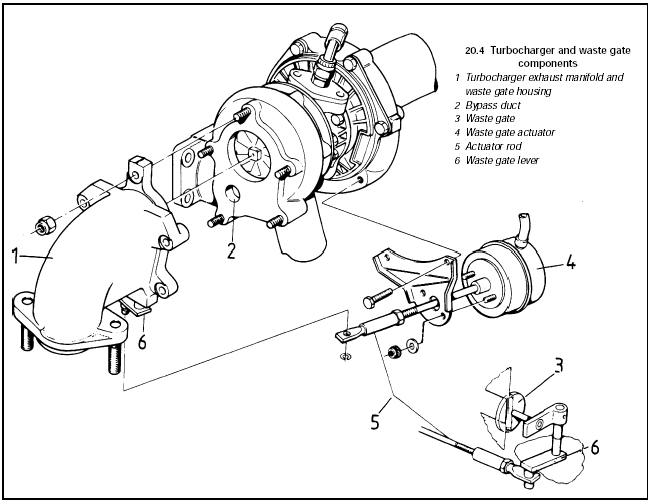Turbocharger - general description
Escort RS Turbo models are equipped with an exhaust driven turbocharger, which is a device designed to increase the engine’s power output without increasing exhaust emissions or adversely affecting fuel economy. It does so by utilising the heat energy present in the exhaust gases as they exit the engine.
Basically the turbocharger consists of two fans mounted on a common shaft. One fan is driven by the hot exhaust gases as they rush through the exhaust manifold and expand.
The other draws in fresh air and compresses it before it enters the inlet manifold. By compressing the air, a larger charge can be let into each cylinder and greater power output is achieved.
The temperature of the inlet air is reduced, thus increasing its density, by passing it through an intercooler, mounted alongside the radiator, prior to it entering the manifold.
The boost pressure generated by the turbocharger is controlled by a waste gate which when open allows a high proportion of the exhaust gases to bypass the turbocharger and directly enter the exhaust system (see illustration).

20.4 Turbocharger and waste gate components
1 Turbocharger exhaust manifold and
waste gate housing
2 Bypass duct
3 Waste gate
4 Waste gate actuator
5 Actuator rod
6 Waste gate lever
The turbocharger therefore loses speed and boost pressure is reduced.
The waste gate is opened and closed by the waste gate actuator through an actuator rod. The waste gate actuator is in turn controlled by the solenoid control valve which receives signals in the form of a pulsed voltage from the ignition system. Electronic Spark Control module (see Chapter 5, Part B).
The Electronic Spark Control module receives data from various engine sensors, particularly the charge air temperature sensor in the inlet air duct, which modify the module program to suit all operating conditions. he module then signals the solenoid control valve to open or close the waste gate via the waste gate actuator.
Lubrication oil for the turbocharger is taken from the engine lubricating circuit via a special branch line. The turbocharger shaft rotates in plain bearings through which a relatively large amount of oil is allowed to pass. Therefore when rotating, the shaft floats on a thick film of lubricating oil.
The turbocharger is a close tolerance, expensive component and servicing or repairs should be left to a dealer service department or specialist with turbocharger repair experience. Apart from the information in the following Sections, any other work on the turbocharger or its related components is beyond the scope of the average reader.
See also:
Spark plug renewal (Every 12 000 miles or 12 months)
The procedure is as described for RS Turbo
models in Section 15. ...
Front suspension strut - removal, overhaul and refitting
Removal
1 Slacken the roadwheel bolts, raise the front
of the vehicle and support it securely on
stands (see “Jacking and Vehicle Support”),
then remove the roadwheel.
2 Support the underside of ...
Front anti-roll bar - removal and refitting
Removal
1 To improve access, raise the front of the
vehicle on ramps. Do not jack the vehicle up
at this stage. Apply the handbrake.
2 Where applicable bend back the locktabs,
then unscrew the tw ...
